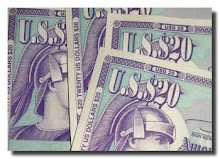March 3 (Bloomberg) -- What a difference a year makes.
Each year, Jim Reid and his colleagues at Deutsche Bank AG publish an influential analysis of credit markets that puts current yields and fundamentals in historical perspective.
If you buy a bond from a company that might go bankrupt, then you expect to receive a higher interest rate. In an efficient and well-functioning market, the higher yield in a diversified portfolio of such bonds should offset the losses you would incur over time because of defaults. If a 10-year Treasury is yielding 4 percent, then you should only buy a 10-year bond from a company with a good chance of defaulting if the yield is significantly higher than 4 percent.
How much higher? That is exactly the question addressed with impressive analytical precision by the Deutsche Bank report. It provides a great thermometer reading of the bond market. The report calculates how large the default probabilities must be to command the current yields on different classes of bonds.
A comparison of this year's report with last year's provides a striking and even startling view of how rough the credit crisis has become.
``Last year, spreads on high-yield bonds were so low, that you could have expected to lose money if you purchased them, even if they defaulted at the lowest rate in history,'' Reid, head of fundamental credit research at Deutsche Bank in London, said in an interview last week. ``This year, spreads are so high that you can expect to make money even if they default at the highest rate in history.''
Default Rate
That's one way to say that corporate bonds look like a good buy right now. If you think about it in terms of implied default probabilities, the analysis gets downright shocking.
Looking at the iBoxx Dollar Liquid Investment Grade Index, Reid and his colleagues estimate that current spreads imply that 19 percent of five-year bonds in the index will default during the next five years. This is an unbelievably high rate.
The highest default rate for these bonds was just 2.4 percent, and the average rate since 1970 was 0.8 percent.
From Citigroup Inc. to JPMorgan Chase & Co., financial firms have been particularly hard hit in this crisis. This is apparent in Reid's numbers as well.
Current prices suggest that 21 percent of five-year bonds in the financial industry are expected to default during the next five years. This places financial bonds -- the debt of some of the bluest of blue-chip firms -- smack dab between single A- rated bonds (which have an implied expected default rate of 20 percent) and BBB-rated bonds (which have an implied expected default rate of 22 percent.)
Historical Record
Those implied default rates are also way outside of historical experience. The highest five-year default rate for A- rated bonds was 2.5 percent. The most for BBB-rated bonds was 5.8 percent.
The mayhem, of course, hasn't just affected five-year bonds. Longer maturities have even more extreme default scenarios priced in. Current prices suggest that 29 percent of corporate bonds will default over the next 10 years. That rate is six times higher than any 10-year period since 1970.
It is worth noting that these default probabilities are probably somewhat inflated, as default risk isn't the sole consideration when looking at bond prices. Even so, the market is pricing in a bond-market catastrophe that's far worse than anything that has ever happened.
Expecting a Calamity
What should one make of these numbers? Even an optimist should be startled by what bond markets are saying. The market isn't just expecting a downturn; it's expecting a calamity. A University of Chicago-style believer in the absolute wisdom of markets should be loading up on canned goods and checking the fortification of his underground bunker.
A more rational response to this report might be to recognize that markets, while they are right on average, tend to overreact in both directions. A person with this sentiment would have looked at last year's prices and concluded that they were irrationally low. Now, panic has set in, and spreads are way too high, pricing in something close to the end of civilization.
The world economy has survived wars, oil embargoes and even a depression. That suggests it can survive this, too, even if things get worse before they get better. If you believe that, then a buy-and-hold strategy on bonds looks about as good as it ever will. If enough investors see that, then this credit crunch might finally begin to ease.
(Kevin Hassett, director of economic-policy studies at the American Enterprise Institute, is a Bloomberg News columnist. He is an adviser to Republican Senator John McCain of Arizona in his bid for the 2008 presidential nomination. The opinions expressed are his own.)
To contact the writer of this column: Kevin Hassett at khassett@aei.org

